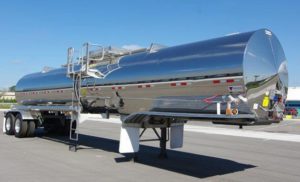A tanker is a motor vehicle designed to carry a number of things including liquefied loads, dry bulk cargo or gases on roads.
The largest vehicles are similar to railroad tank cars which are intended to carry liquefied loads. Many variants exist due to the wide variety of liquids that can be transported. Tankers can be insulated or non-insulated; pressurized or non-pressurized; and designed for single or multiple loads. The sizes and axle configurations are determined by the commodities hauled, we see multiple applications ranging from Tandem, Tridem, Quad Quint and B train options, 6 and 8 axles options are also seen being utilized in the US especially in Michigan but we see many more configurations in the Continental US. Tankers are almost always created with internal divisions in their tank or contain multiple compartments to prevent load movement destabilizing the vehicle.
A tank truck is distinguished by its shape, usually a cylindrical tank upon the vehicle laying horizontally. Some less visible differences between tank trucks have to do with their intended use: compliance with human food regulations, refrigeration capability, acid resistance, pressurization capability and more.
The industry standard for tanker trucks hauling all these types of commodities is very hard to peg down, as products are measured in barrels, cubes, cubic feet, tons, US gallons, Litres and Imperial gallons.
However, when we look at State and Provincial regulations each have unique and limited characteristics to the available capacity that each commodity/product can be hauled, In Canada there are 2 standards that are accepted nationwide, that is the tandem and B train configs. Please visit the website at transcourt.com/white-papers to see our guide to weights and axle configs.


Recent Comments